Why you can trust Tom's Hardware
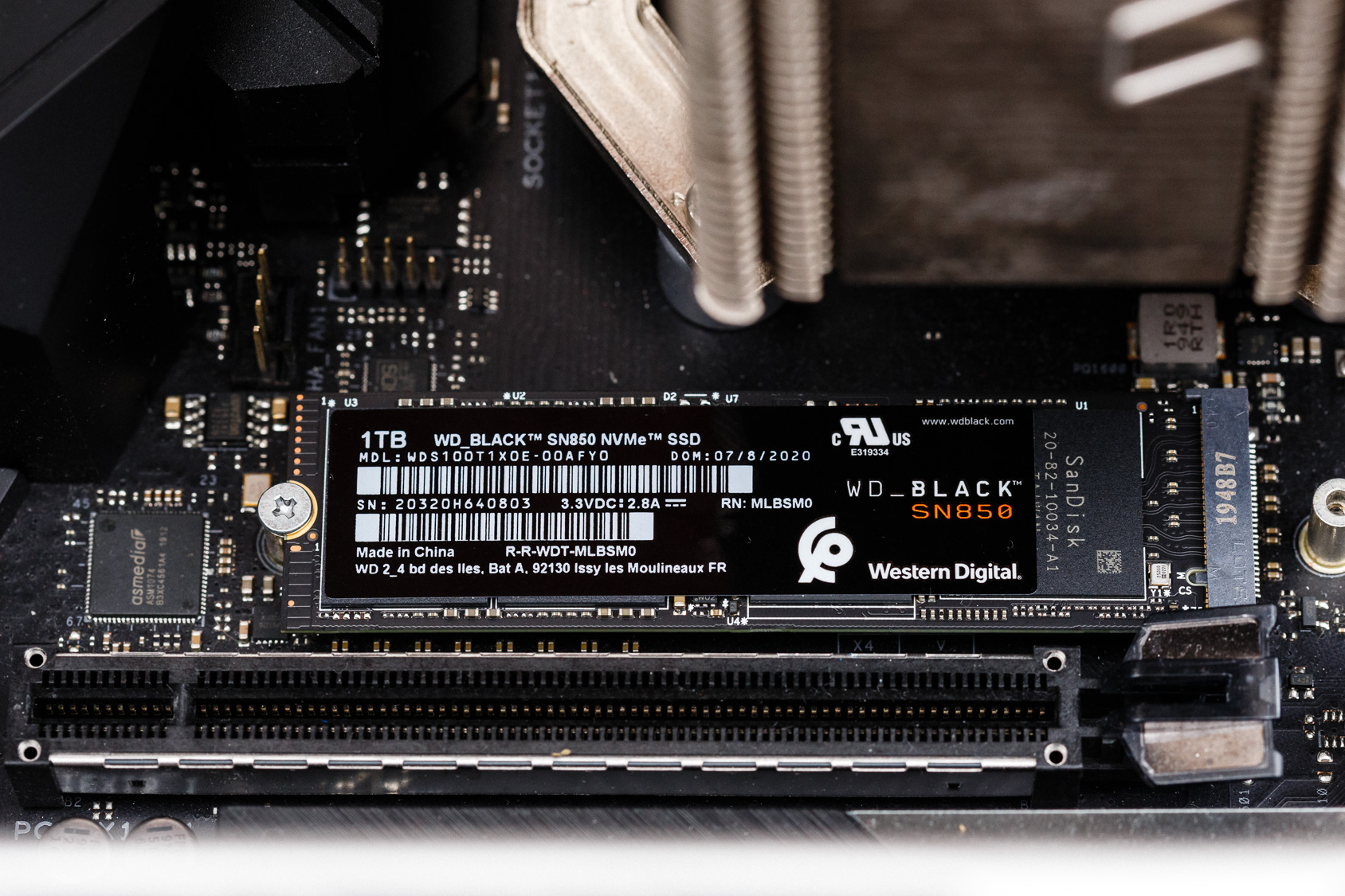
Performance Results for WD Black SN850 1TB
Rating: 4.5 (Editor's Choice)
Verdict: WD’s Black SN850 is a high-performance PCIe 4.0 x4 M.2 NVMe SSD that was built from the ground up as the company’s fastest SSD for gamers and prosumers. Trading blows with Samsung’s best, it marks a dramatic improvement over its predecessor, ranking it as one of the best SSDs on the market.
FOR
+ Competitive performance
+ Large dynamic SLC cache
+ Black PCB
+ Software package
+ 5-year warranty
AGAINST
- Hot under heavy load
- High idle power consumption on desktop test bench
- AES 256-bit encryption not supported
Comparison Products for WD Black SN850 1TB
We threw the WD Black SN850 into the ring with its predecessor, the Black SN750, its little brother, the Blue SN550, as well as some of the best SSDs available. From Samsung, we included the 970 EVO Plus, 970 PRO, and the company’s newest flagship SSD, the 980 PRO. We also included the Team Group Cardea Ceramic C440, a PCIe Gen4 SSD powered by Phison’s E16 NVMe controller, and Intel’s ridiculously fast Optane SSD 905P. And, for some added Gen3 competition, we tossed SK hynix’s Gold P31and Crucial’s P5 into the mix.
Get Tom's Hardware's best news and in-depth reviews, straight to your inbox.
Game Scene Loading - Final Fantasy XIV
Final Fantasy XIV Stormbringer is a free real-world game benchmark that easily and accurately compares game load times without the inaccuracy of using a stopwatch.
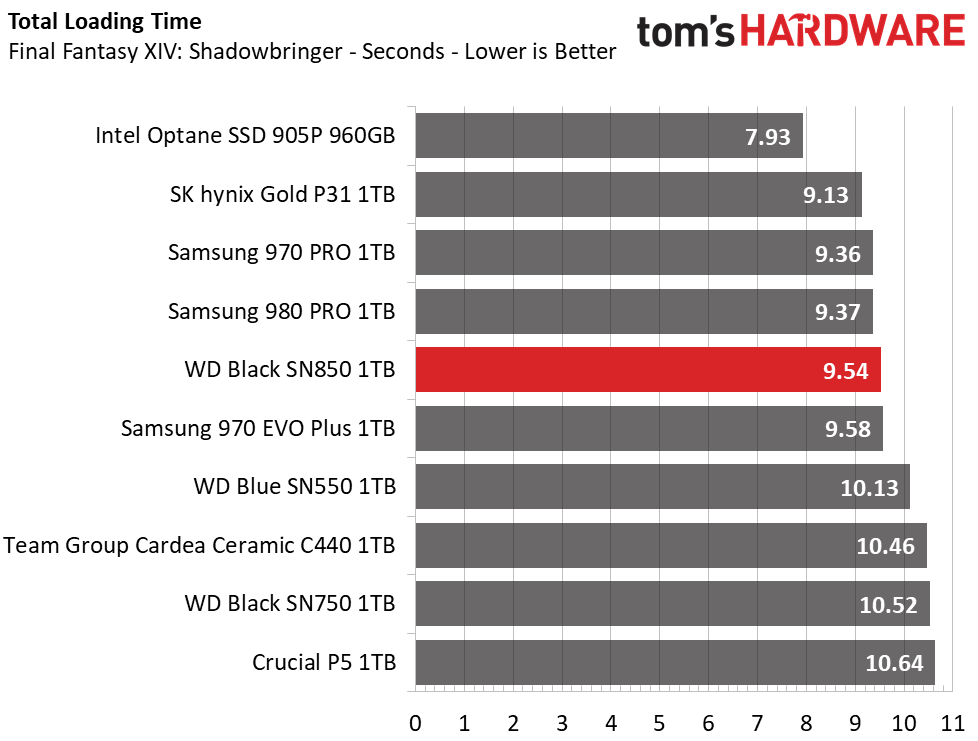
Intel’s Optane 905P is the fastest performing SSD in this game load benchmark, followed by the SK hynix and both the Samsung 970 and 980 PROs. WD’s Black SN850 takes fourth place, also delivering very responsive game load times and well ahead of the Phison E16-based Team Group.
Transfer Rates – DiskBench
We use the DiskBench storage benchmarking tool to test file transfer performance with our own custom blocks of data. Our 50GB dataset includes 31,227 files of various types, like pictures, PDFs, and videos. Our 100GB dataset consists of 22,579 files, with 50GB of them being large movies. We copy the data sets to new folders and then follow-up with a read test of a newly-written 6.5GB zip file and 15GB movie file.
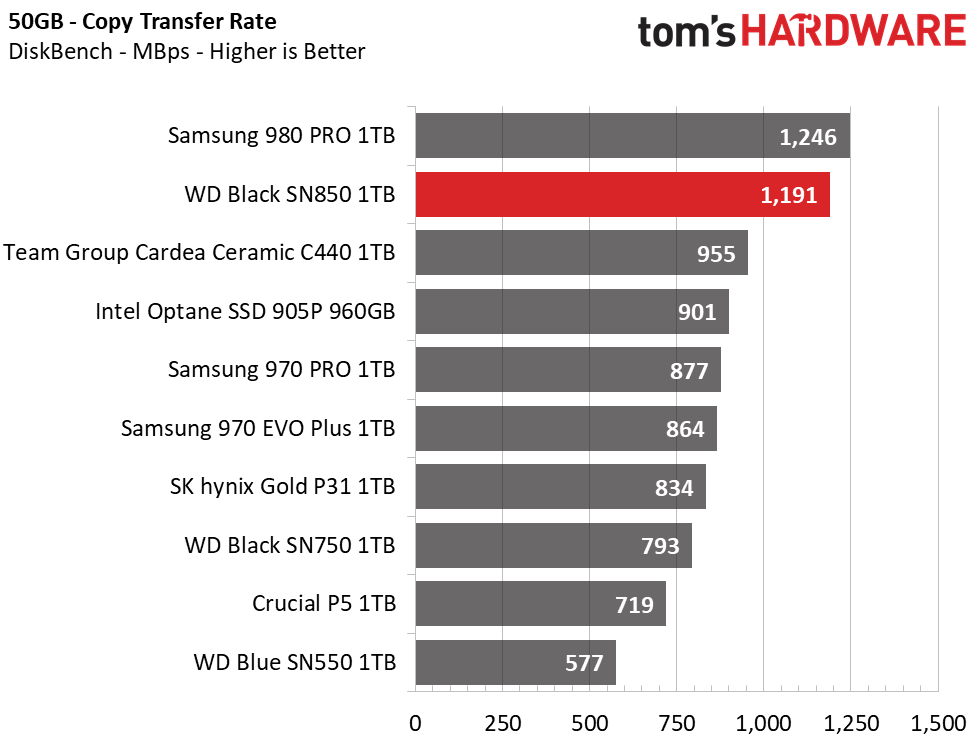
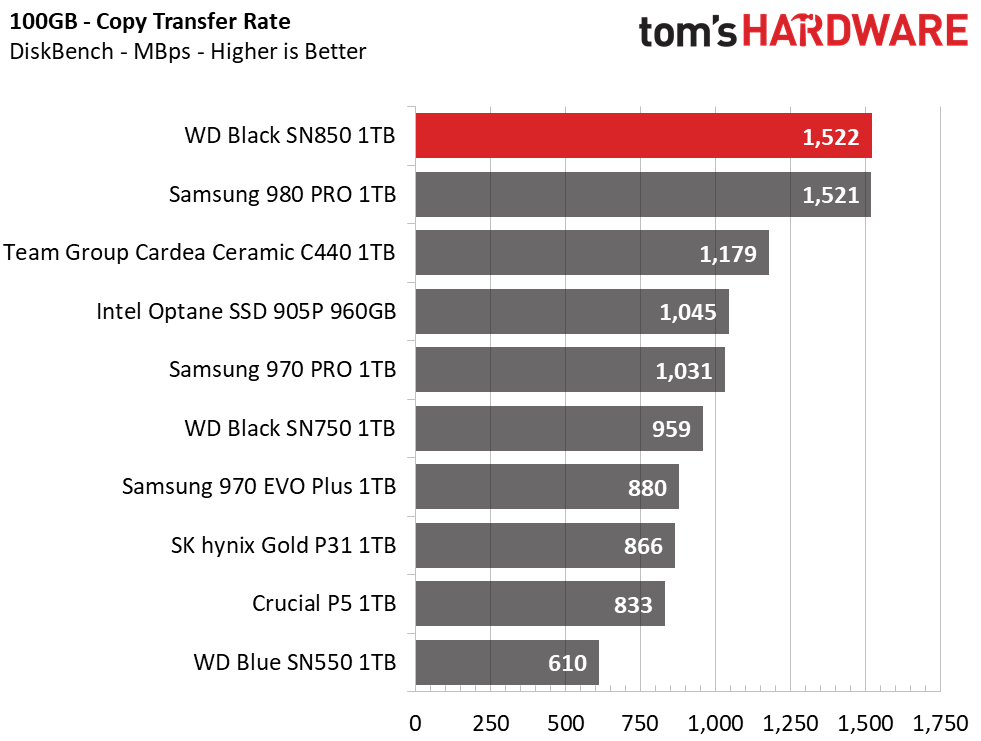
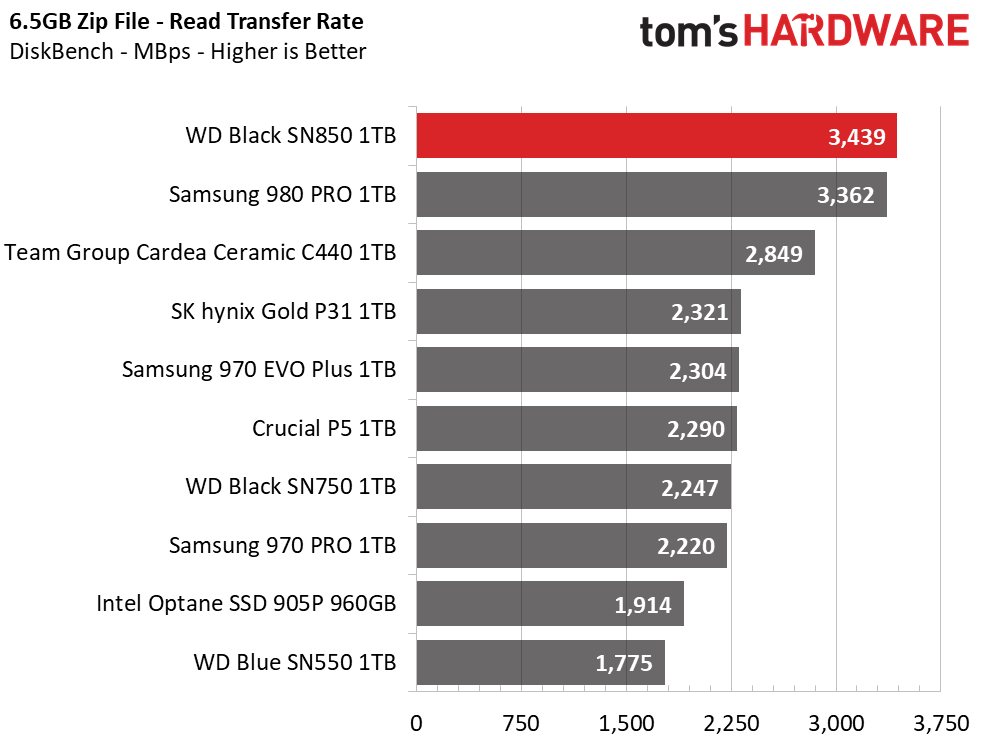
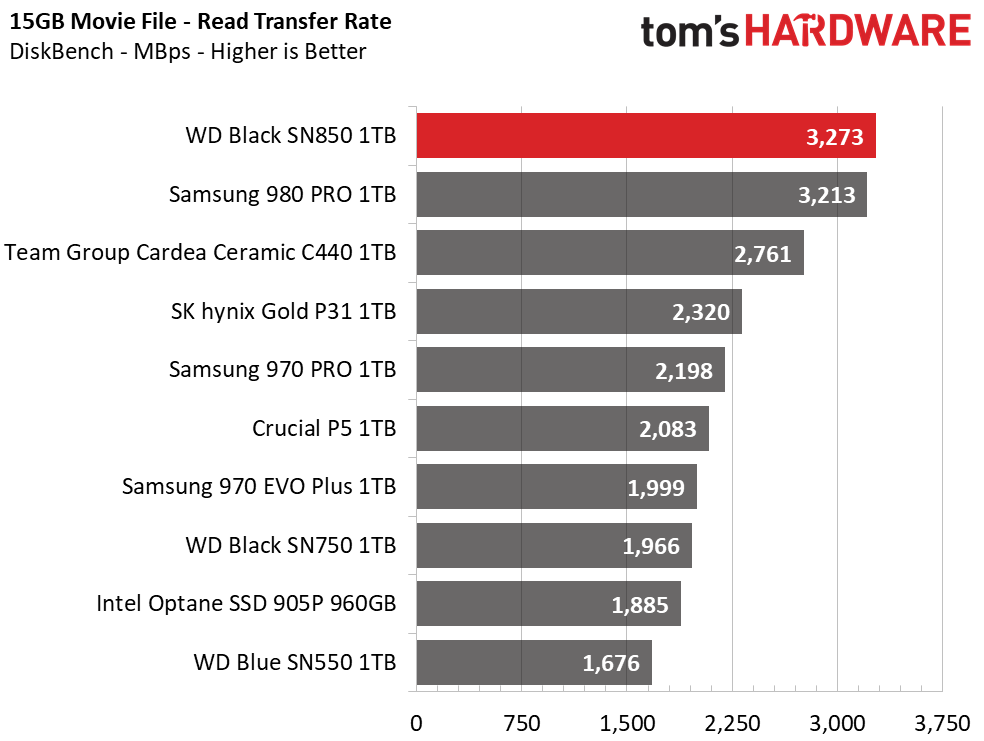
When it comes to large file transfers, WD’s Black SN850 delivers top-notch results, outperforming Samsung’s best in three out of the four transfers. The Samsung 980 PRO copied the 50GB folder faster due to its slightly faster random performance. Still, the two essentially tied during the larger transfer, and WD’s Black SN850 displaced the Samsung 980 PRO as the fastest thing going when reading back our large test files.
Trace Testing – PCMark 10 Storage Tests
PCMark 10 is a trace-based benchmark that uses a wide-ranging set of real-world traces from popular applications and everyday tasks to measure the performance of storage devices. The quick benchmark is more relatable to those who use their PCs for leisure or basic office work, while the full benchmark relates more to power users.
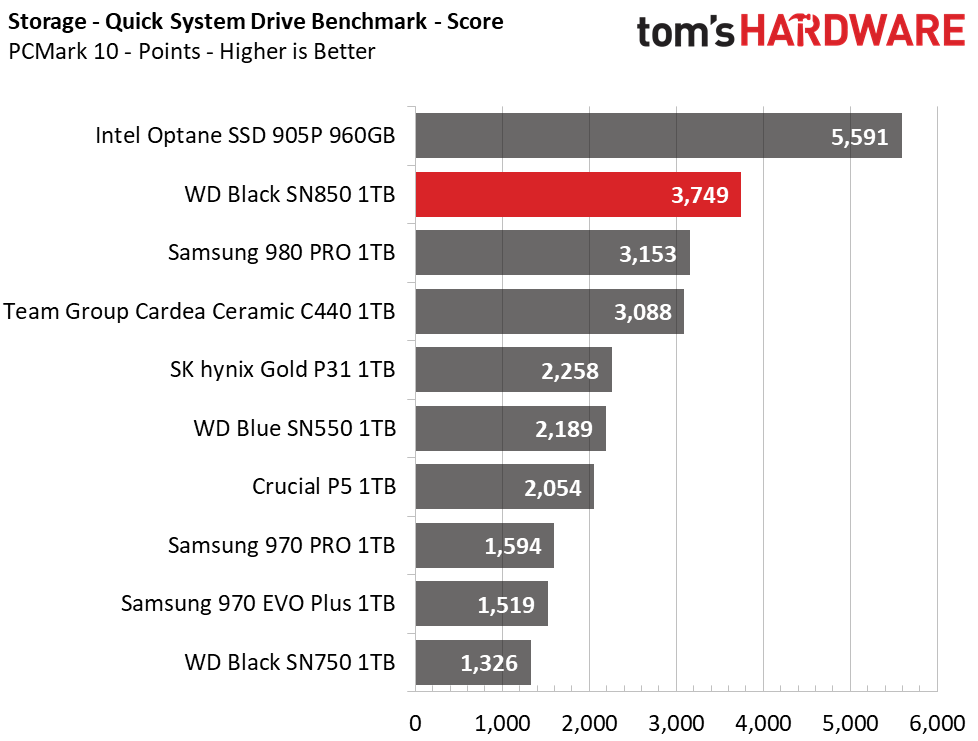
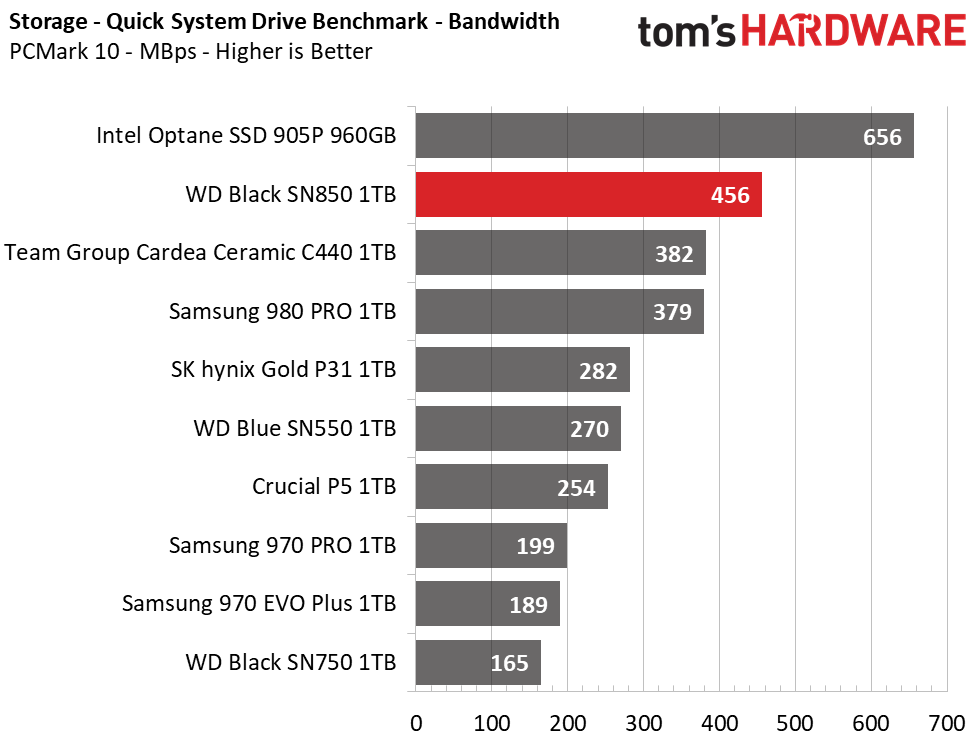
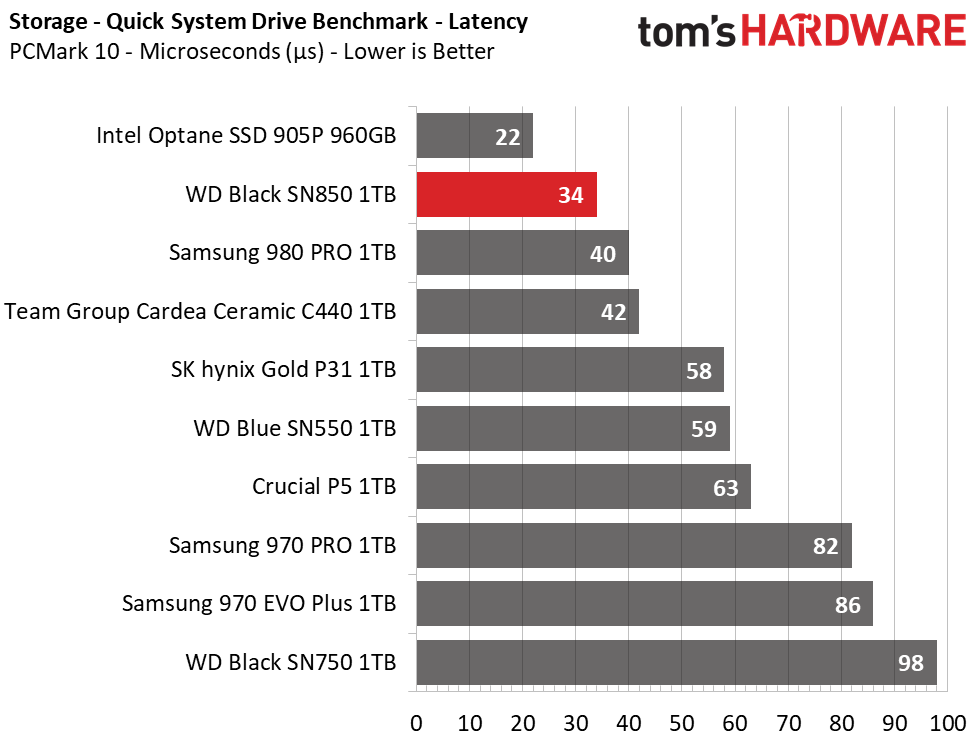
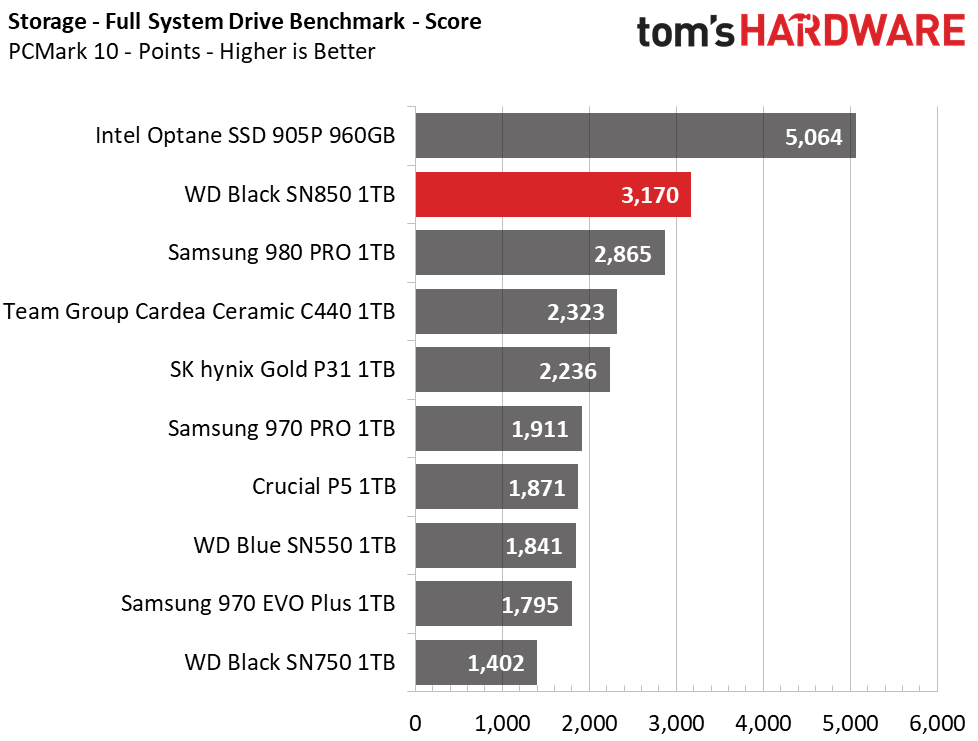
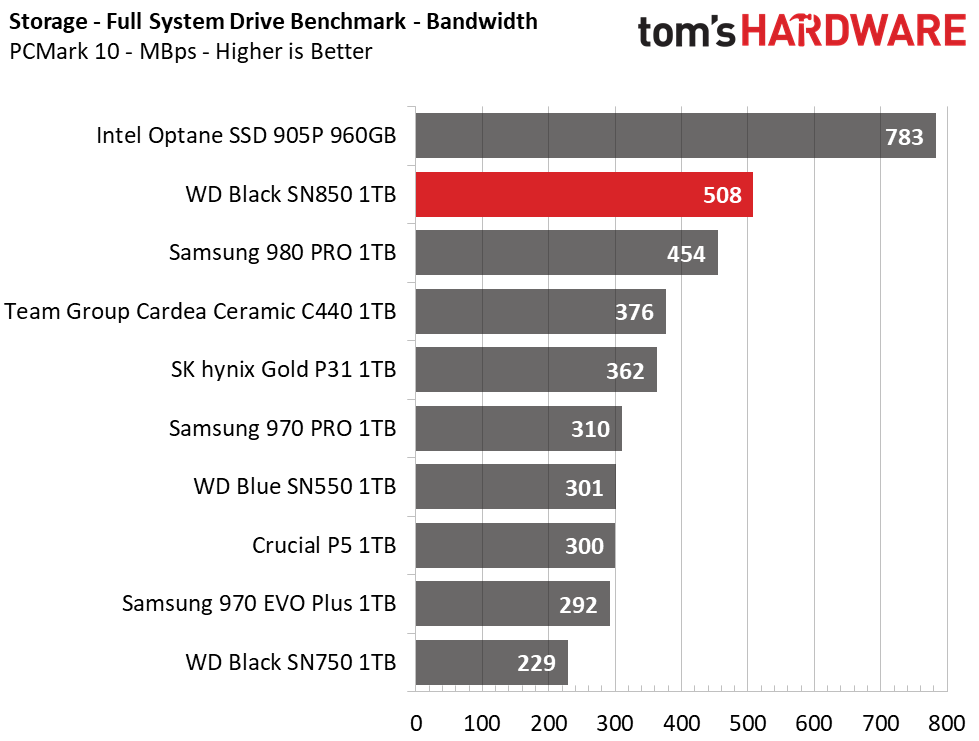
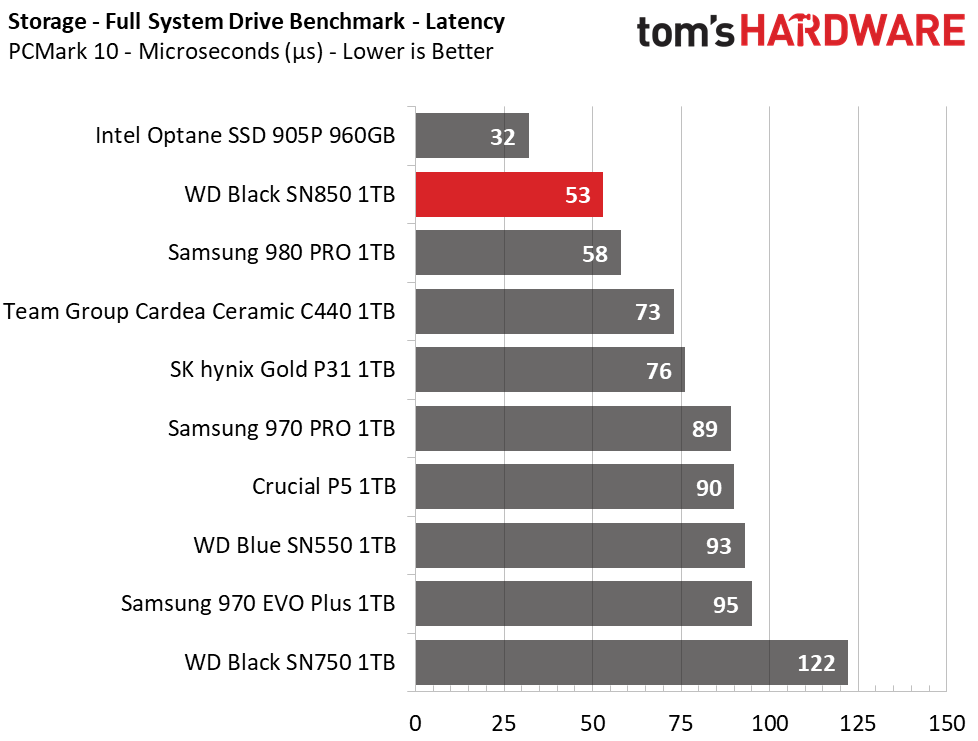
To say WD tweaked n’ tuned the Black SN850 is an understatement. WD’s Black went from just 'alright' with the SN750, to the SN850 now surpassing Samsung’s flagship SSD in both the Quick and Full Drive benchmarks. WD’s Black SN850 smashed the Samsung 980 PRO’s scores by 16% and 10%, respectively, marking a substantial improvement in the company’s SSD architecture.
Trace Testing – SPECworkstation 3
Like PCMark 10, SPECworkstation 3 is a trace-based benchmark, but it is designed to push the system harder by measuring workstation performance in professional applications.
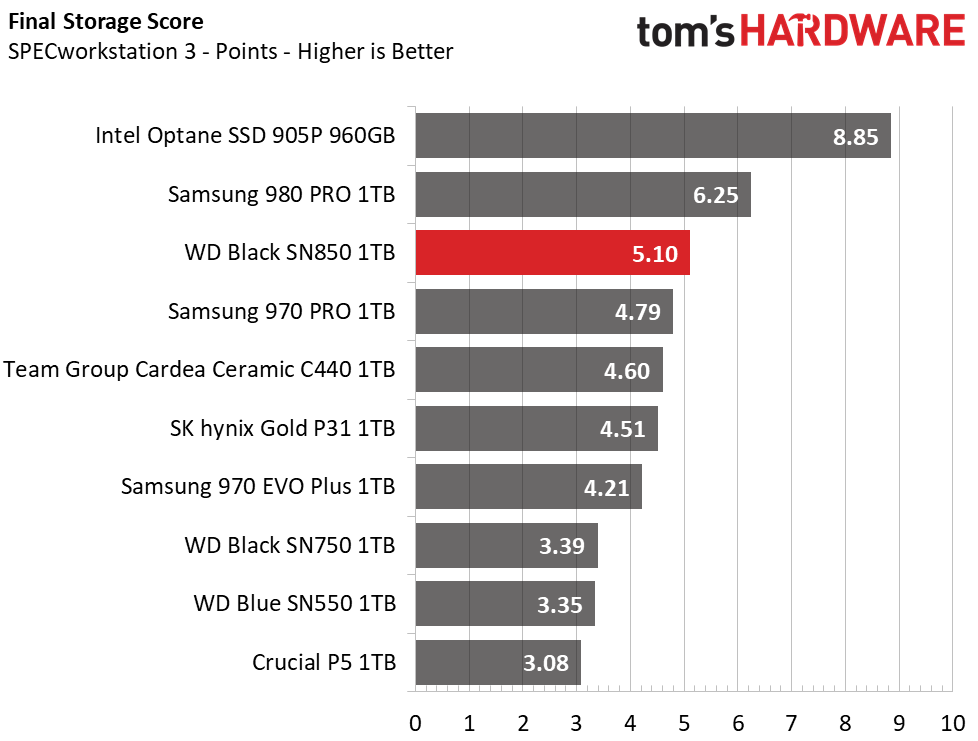
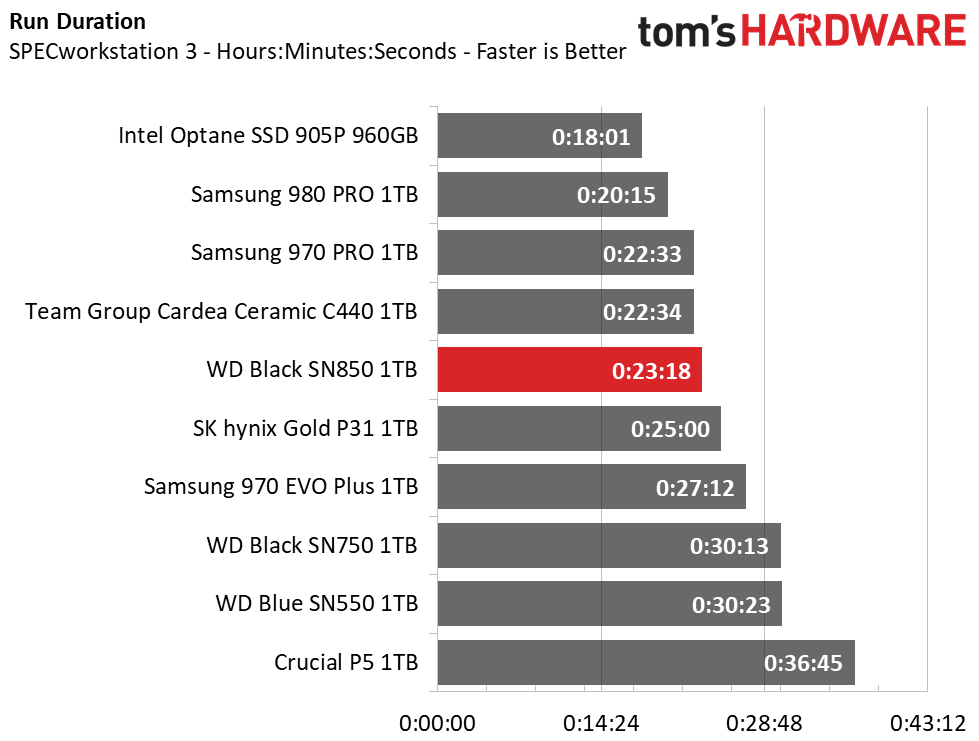

Intel’s Optane SSD 905P is the current champ if you need the most responsive and durable SSD for your application, but WD’s Black delivers respectable results in comparison. WD’s Black SN850 was very responsive to SPECworkstation 3’s bombardment of diverse workloads but ultimately trails Samsung’s 980 PRO, scoring third place overall.
Synthetic Testing - ATTO / iometer
iometer is an advanced and highly configurable storage benchmarking tool while ATTO is a simple and free application that SSD vendors commonly use to assign sequential performance specifications to their products. Both of these tools give us insight into how the device handles different file sizes.
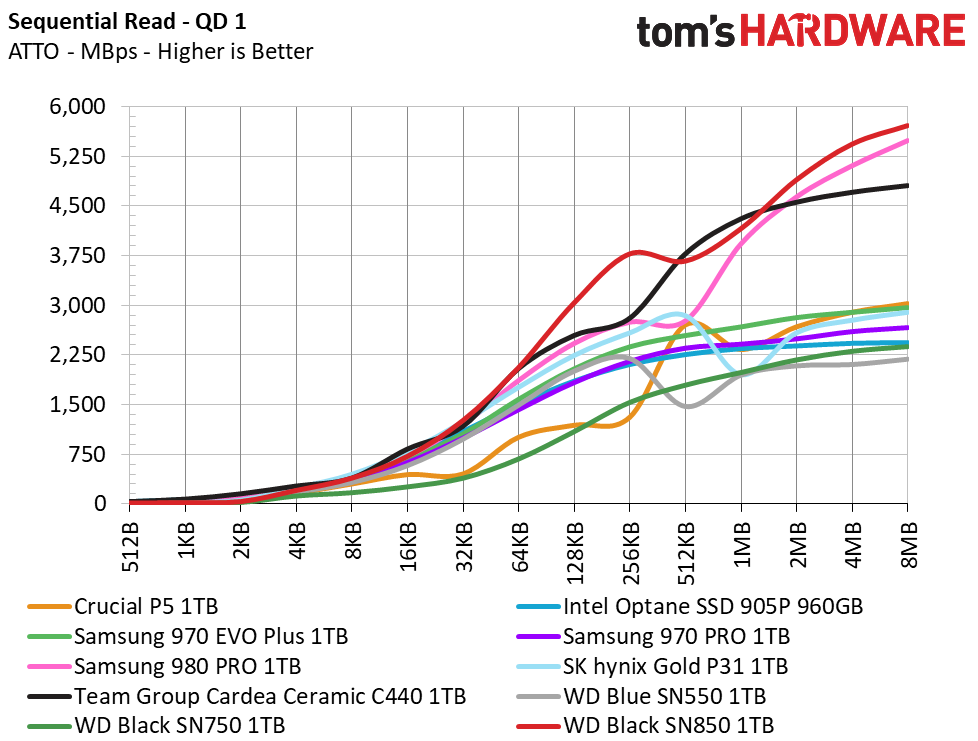
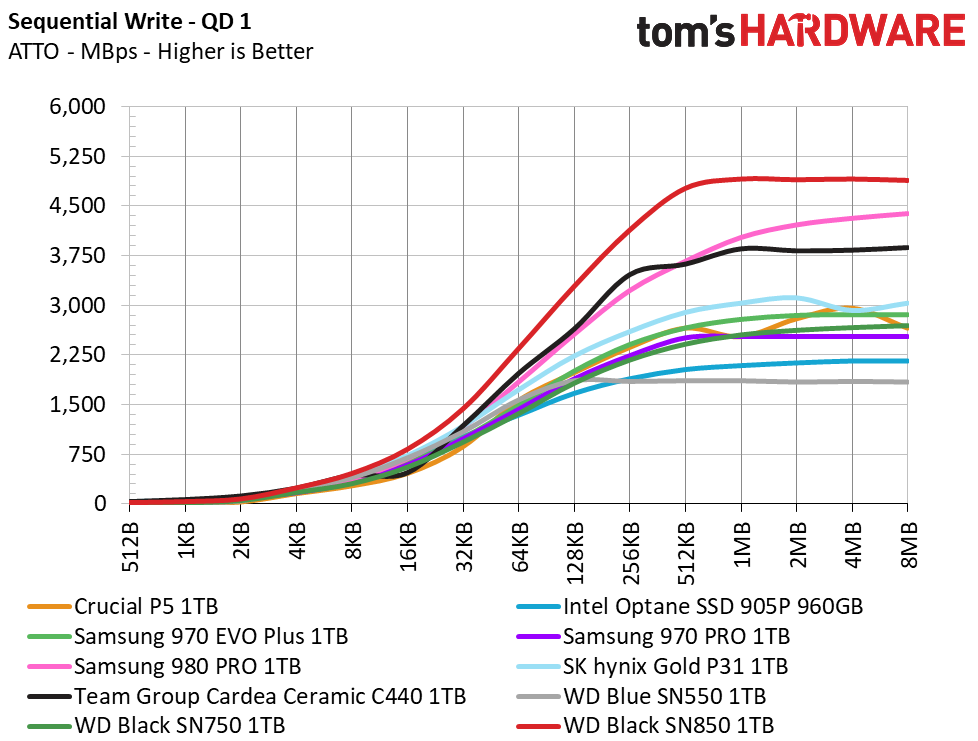
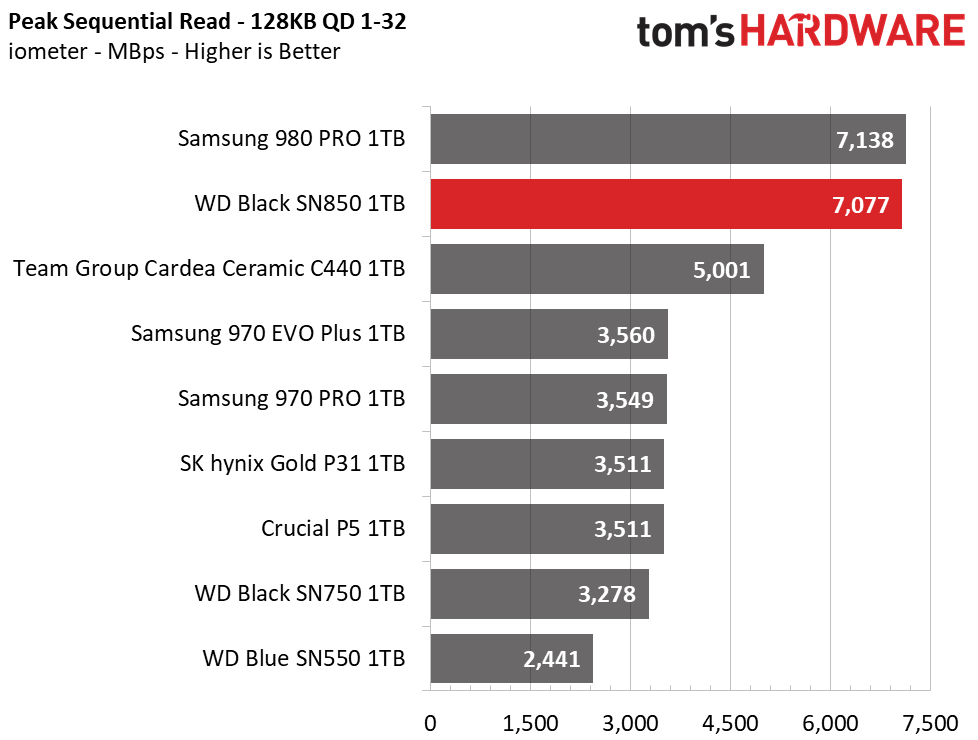
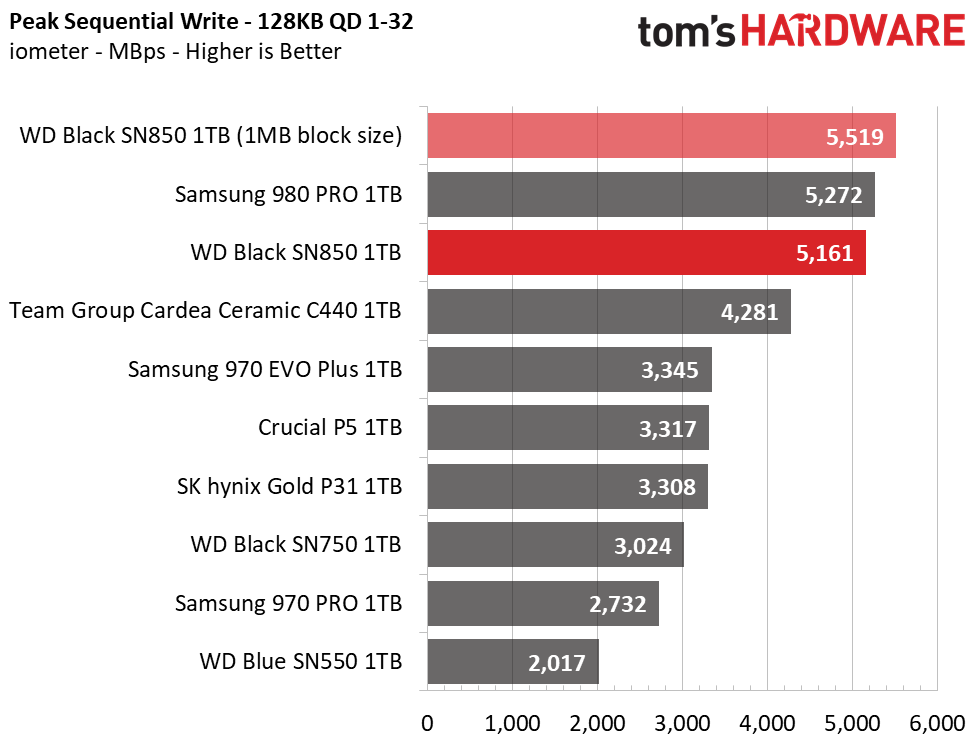

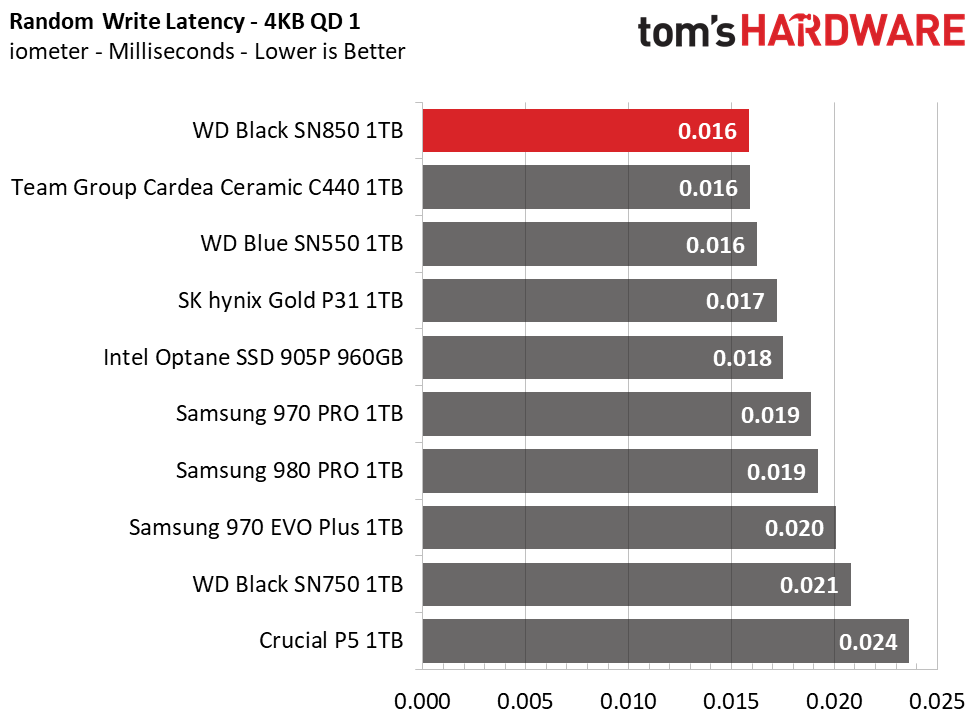
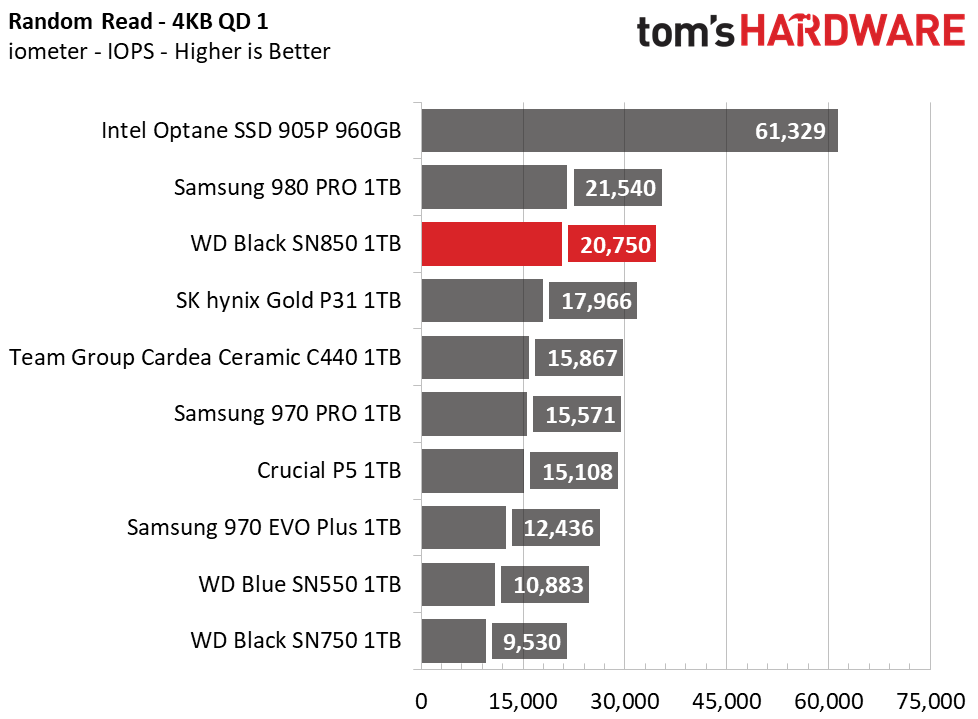
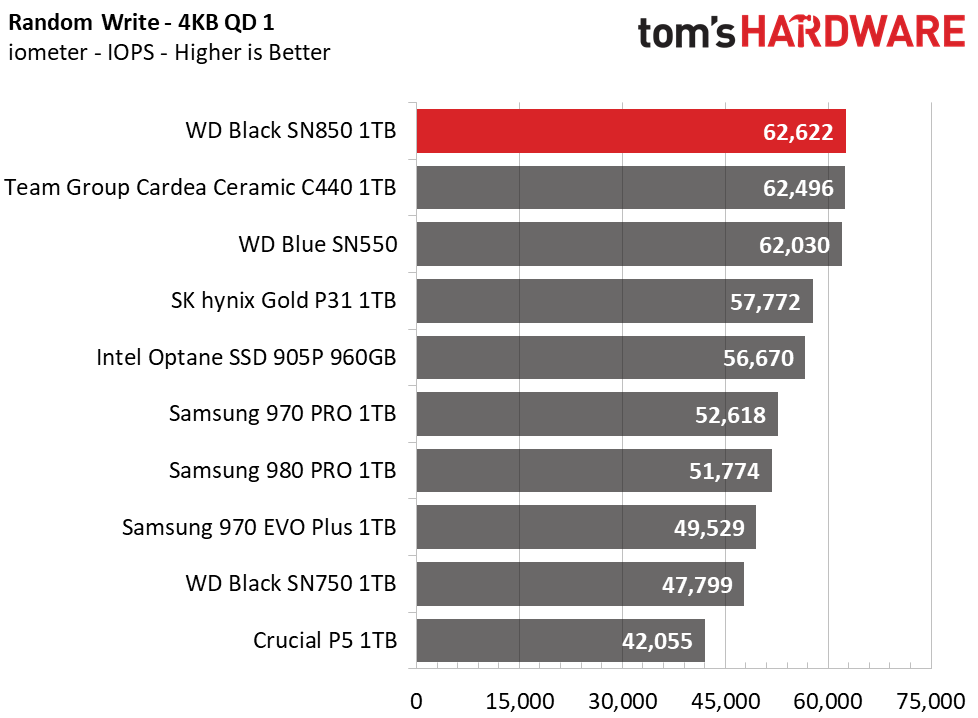
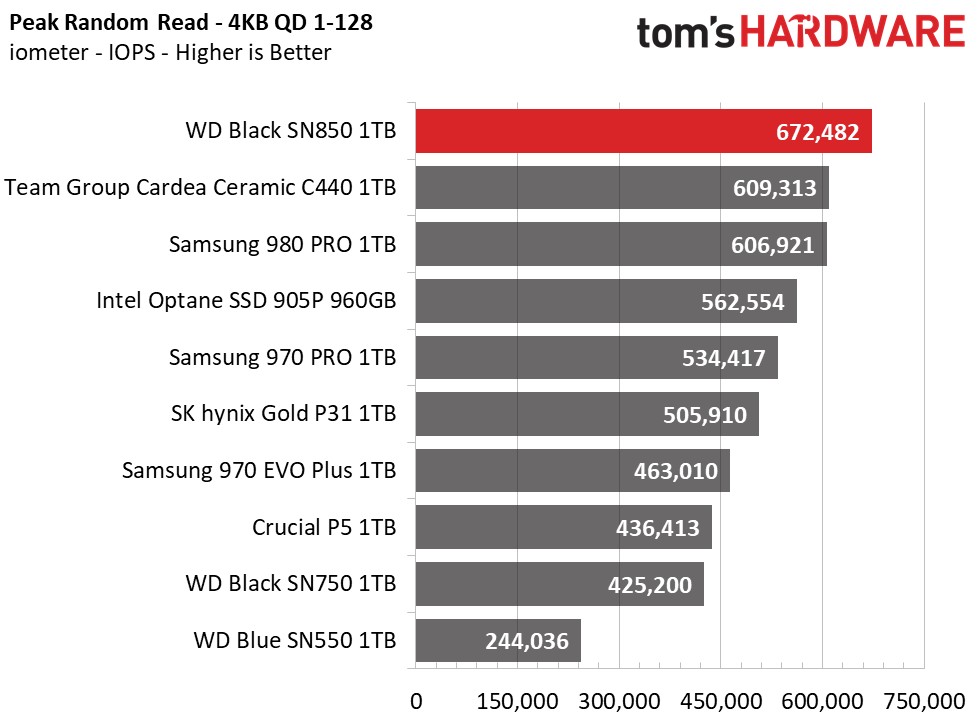
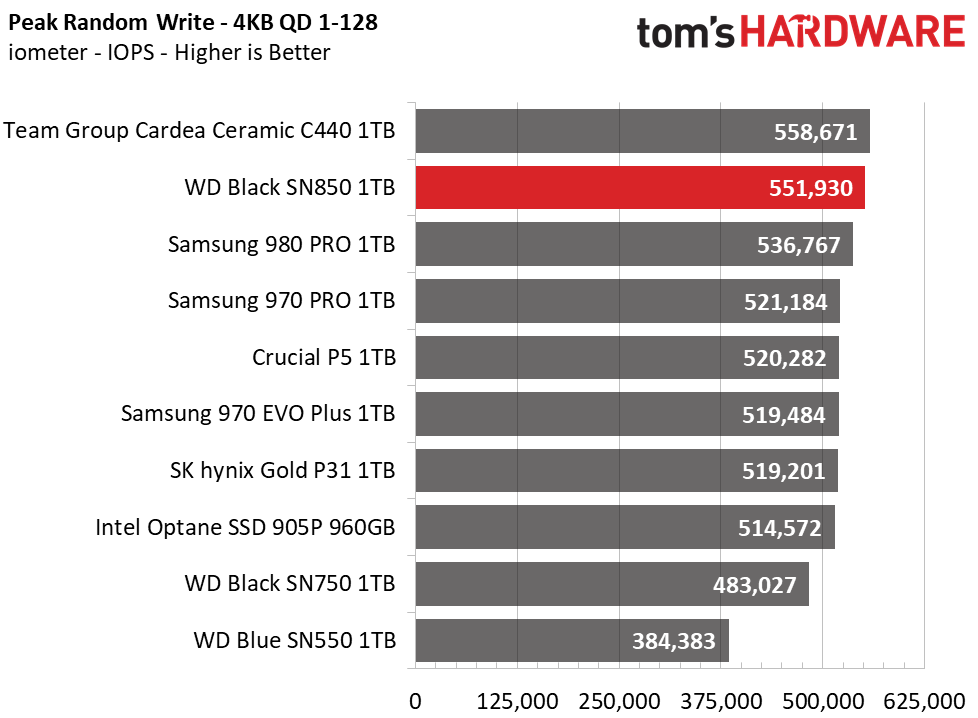
We tested WD’s Black SN850 at a queue depth (QD) of 1 as it represents most day to day file access at various block sizes. WD’s Black SN850 delivers competitive sequential performance that even eclipses the test pool’s results at some file sizes, especially its write capability. When bumping up the queue depth, peak sequential results clocked in at 7.1/5.2 GBps read/write with a 128KB block size, and write speed increased to just over 5.5 GBps when we increased the block size to 1MB.
In terms of random performance, WD’s Black delivers top-notch results with read latency clocking in at 0.048ms, roughly 21K IOPS at a QD of 1. Even scaling up to a QD of 128 the WD shows strong read and write performance, scoring first or second place in most metrics.
Sustained Write Performance and Cache Recovery
Official write specifications are only part of the performance picture. Most SSDs implement a write cache, which is a fast area of (usually) pseudo-SLC programmed flash that absorbs incoming data. Sustained write speeds can suffer tremendously once the workload spills outside of the cache and into the "native" TLC or QLC flash. We use iometer to hammer the SSD with sequential writes for 15 minutes to measure both the size of the write cache and performance after the cache is saturated. We also monitor cache recovery via multiple idle rounds.
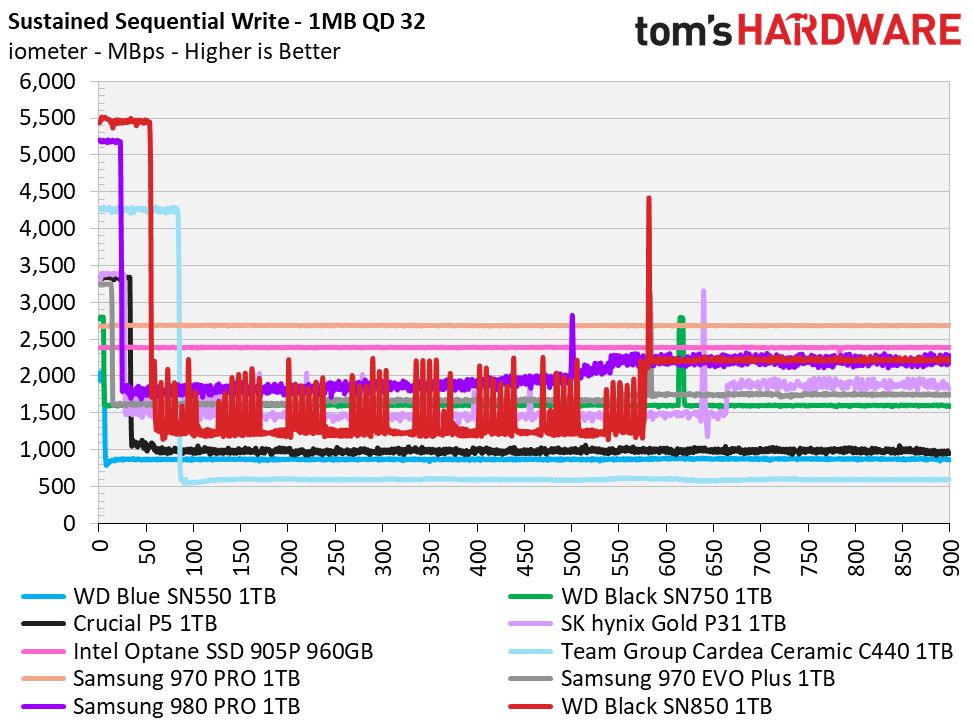

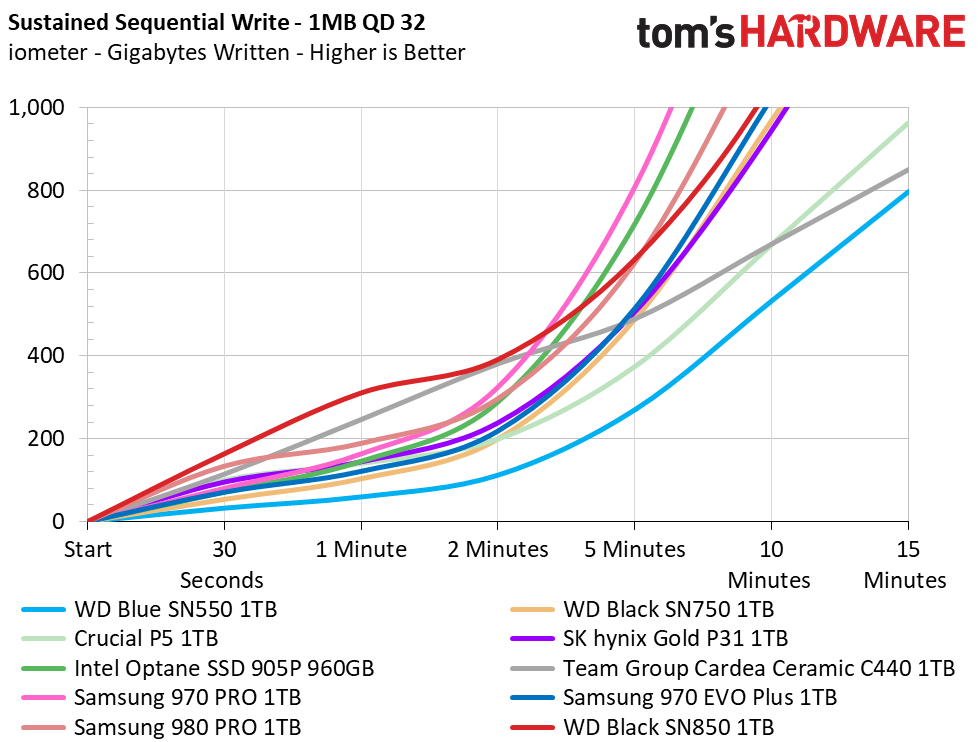
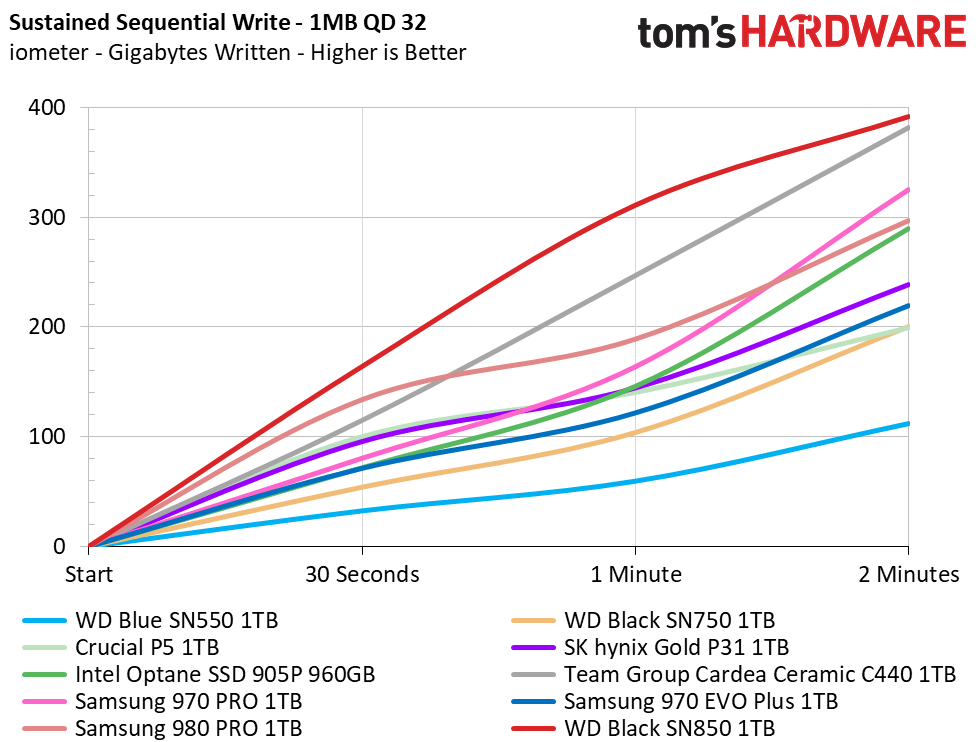
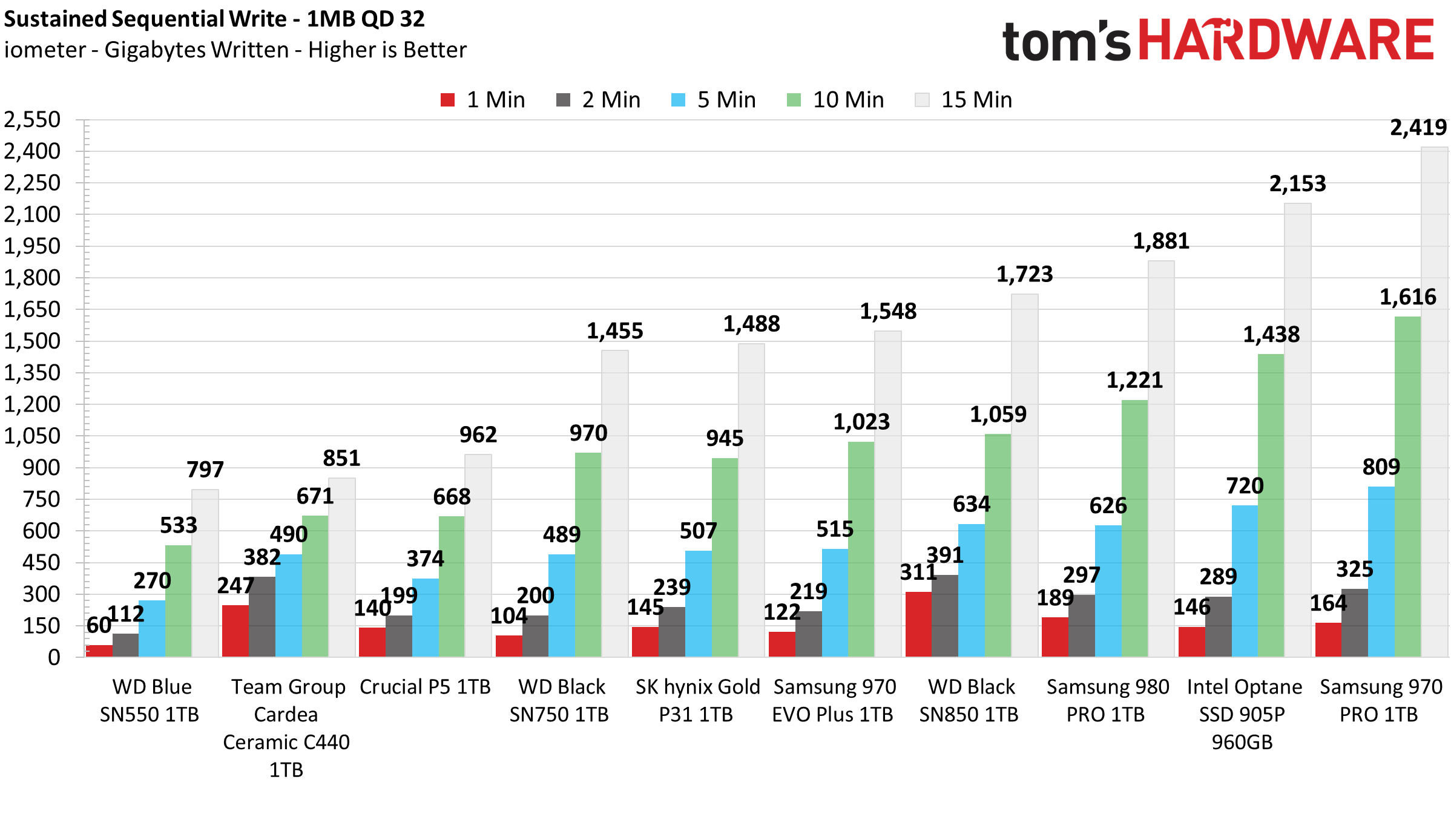
WD’s nCache 4.0 enables massive dynamic SLC cache capacity while also maintaining consistent QoS by using a small and quick-to-recover static cache. From empty, our 1TB sample filled within 10 minutes, writing 300GB of data at a rate of 5.5 GBps before degrading to an average rate of 1.34 GBps. This propelled it well ahead of the competition up until roughly the five-minute mark, but it gave way to Samsung’s top drives along with Intel’s Optane 905P beyond that.
Power Consumption and Temperature
We use the Quarch HD Programmable Power Module to gain a deeper understanding of power characteristics. Idle power consumption is an important aspect to consider, especially if you're looking for a laptop upgrade. Some SSDs can consume watts of power at idle while better-suited ones sip just milliwatts. Average workload power consumption and max consumption are two other aspects of power consumption, but performance-per-watt is more important. A drive might consume more power during any given workload, but accomplishing a task faster allows the drive to drop into an idle state more quickly, ultimately saving energy.
We also monitor the drive’s temperature via the S.M.A.R.T. data and an IR thermometer to see when (or if) thermal throttling kicks in and how it impacts performance. Bear in mind that results will vary based on the workload and ambient air temperature.
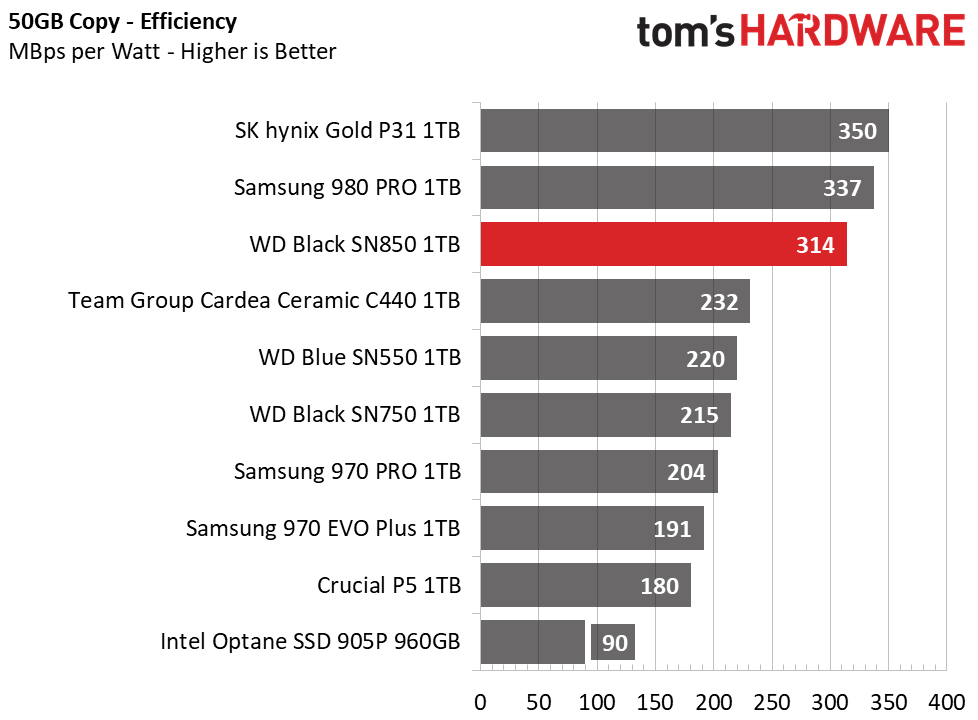
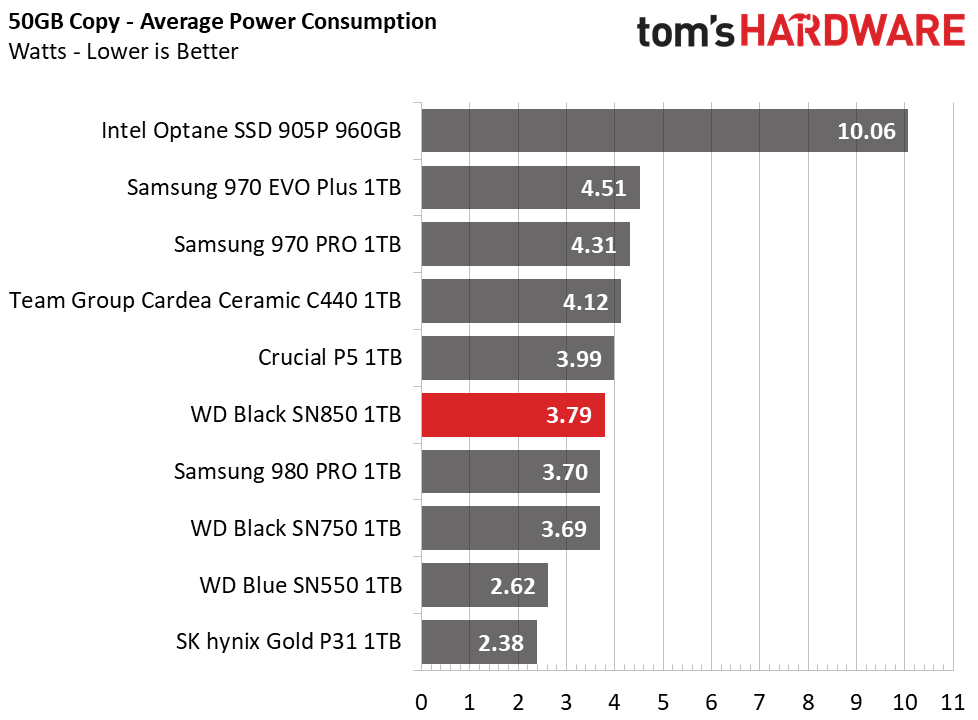
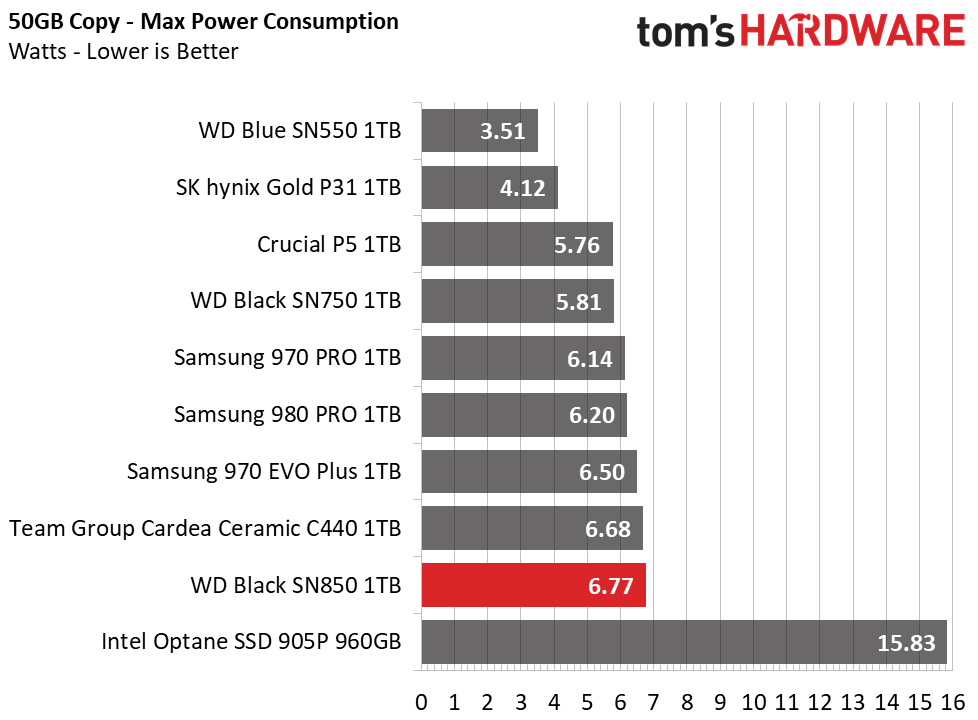
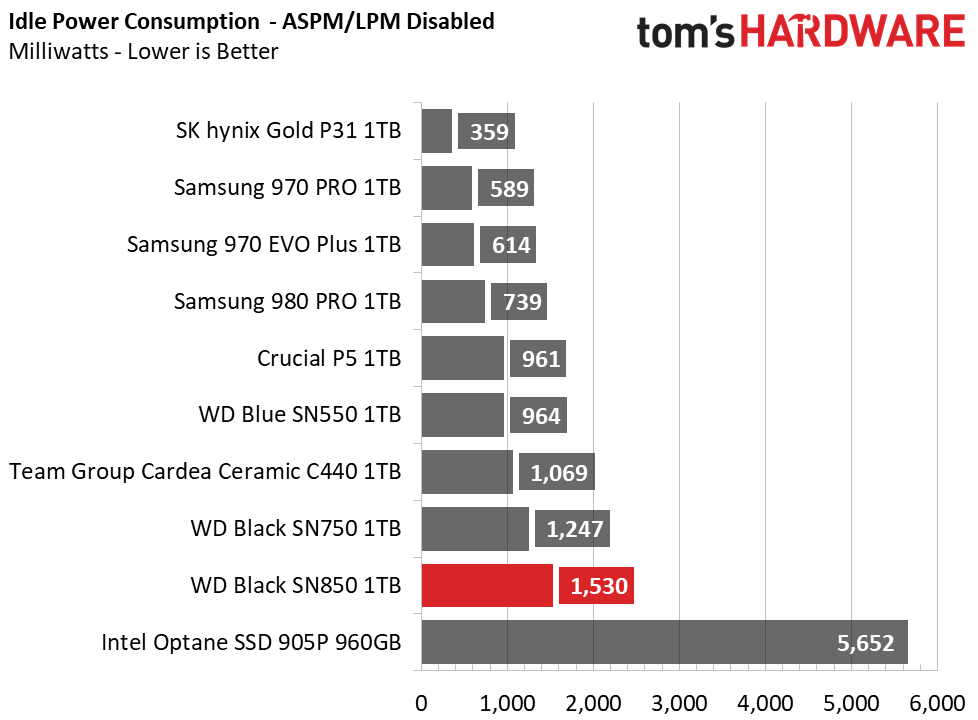
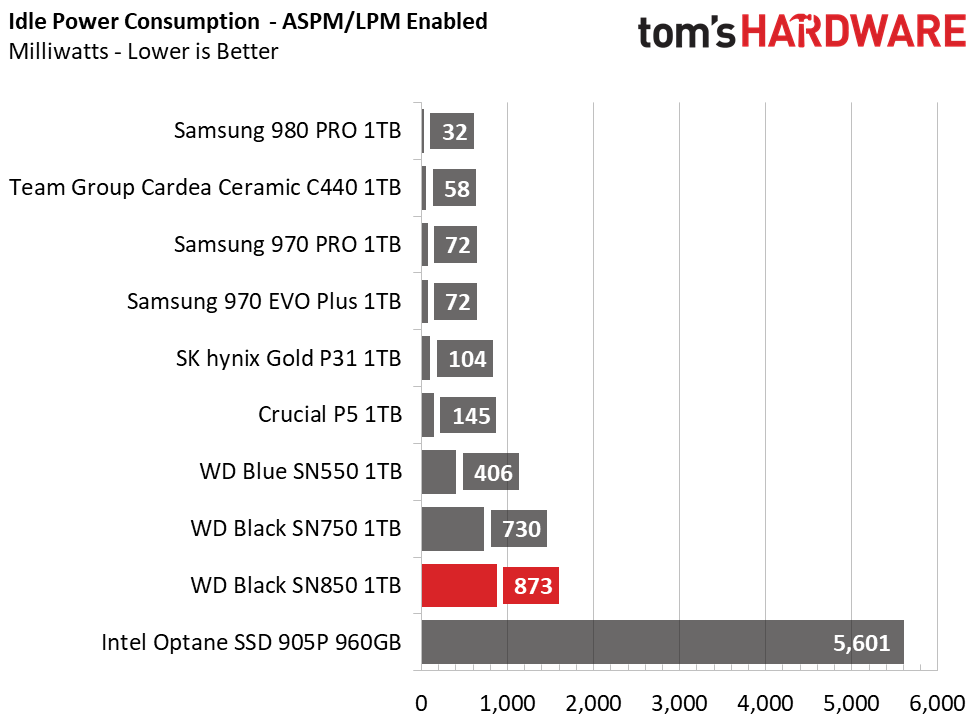
Overall, Samsung’s 980 PRO is more efficient than the Black SN850 under load, but only by a small margin. WD’s Black SN850 consumes roughly 3.8W on average during the transfer test, with peak power consumption tipping the scales at roughly 6.8W. That's more than all other competitors. High idle power consumption may help the Black SN850 when it comes to responsiveness, but not efficiency.
This leads to WD’s Black SN850 running warm at idle with controller temperatures ranging from 47-50C, and it can get quite hot when pushed. After roughly 400GB of writes, our unit throttled once the controller hit 88 degrees Celsius, and its peak temperature measured was roughly 92 degrees Celsius in a 24 degrees Celsius room. For most consumer use cases, the 1TB WD Black won’t throttle to stay cool, but it may under heavy abuse without proper airflow or a heatsink.
MORE: Best SSDs
MORE: How We Test HDDs And SSDs
MORE: All SSD Content

Sean is a Contributing Editor at Tom’s Hardware US, covering storage hardware.
-
Colif super fast but super warm. they releasing one with a heatsink next year, that is probably safer bet although nvme heatsinks aren't that much. The one they releasing has rgb though.Reply -
nofanneeded ReplyColif said:super fast but super warm. they releasing one with a heatsink next year, that is probably safer bet although nvme heatsinks aren't that much. The one they releasing has rgb though.
Most motherboards come with NVME SSD heatsink anyways.
But at this Price I would prefer Samsung 980 pro over it ...
anyways , Samsung 970 evo plus NVME is my choice , no need to pay more IMO -
Victor_S I have two of these on my Crosshair Hero VIII, they do get warm, because they really are super fast. I do not use the built in Asus heatsinks with them, the mother board heatsinks are generally useless for any drive with decent performance. I replaced two older 1TB SN700 Drives and even they went over 55C when gaming most of the time with the Asus heat sinks.. I bought two of these, for $11.99 eachReply
https://www.amazon.com/gp/product/B07KDDKDNN/ref=ppx_yo_dt_b_asin_title_o09_s01?ie=UTF8&psc=1
These heatsinks offer full coverage, front and back, with metal and thermal pads and are very compact and do not interfere with any other components. They look great too, come in lots of different colors, and are dirt cheap. With these full coverage heatsinks they run about 35C under normal Windows use, and I have not seen them break 46C under load. I did not even attempt to try and run them with the stock Asus cover plates,, because that is mostly what they do, cover them, really not a true heatsink when there is an decent amount of heat on the backside of any performance NVME drive that just gets trapped in there and warms up your motherboard underneath too. I
I get amazing performance with these drives, IMO, the SN850 is really the only Gen 4 drive worth spending money one they are that quick. It is also the fastest NVME available at the moment, even beating out Samsung's new 980 Pro. I get slightly over the tested speeds (from another review site). About 7080.00 mb/s read and 5249.80 mb/s write average, when you enable "game mode" in the WD SSD Toolbox. I see noticeable load time decreases in a number of games I play, and even booting Windows. I also work with a large uncompressed audio library, and an even bigger photo library and see gains there as well. Worth every penny if you have a Gen 4 motherboard, or plan to upgrade to one in the near future. -
Makaveli ReplyVictor_S said:I have two of these on my Crosshair Hero VIII, they do get warm, because they really are super fast. I do not use the built in Asus heatsinks with them, the mother board heatsinks are generally useless for any drive with decent performance. I replaced two older 1TB SN700 Drives and even they went over 55C when gaming most of the time with the Asus heat sinks.. I bought two of these, for $11.99 each
https://www.amazon.com/gp/product/B07KDDKDNN/ref=ppx_yo_dt_b_asin_title_o09_s01?ie=UTF8&psc=1
These heatsinks offer full coverage, front and back, with metal and thermal pads and are very compact and do not interfere with any other components. They look great too, come in lots of different colors, and are dirt cheap. With these full coverage heatsinks they run about 35C under normal Windows use, and I have not seen them break 46C under load. I did not even attempt to try and run them with the stock Asus cover plates,, because that is mostly what they do, cover them, really not a true heatsink when there is an decent amount of heat on the backside of any performance NVME drive that just gets trapped in there and warms up your motherboard underneath too. I
I get amazing performance with these drives, IMO, the SN850 is really the only Gen 4 drive worth spending money one they are that quick. It is also the fastest NVME available at the moment, even beating out Samsung's new 980 Pro. I get slightly over the tested speeds (from another review site). About 7080.00 mb/s read and 5249.80 mb/s write average, when you enable "game mode" in the WD SSD Toolbox. I see noticeable load time decreases in a number of games I play, and even booting Windows. I also work with a large uncompressed audio library, and an even bigger photo library and see gains there as well. Worth every penny if you have a Gen 4 motherboard, or plan to upgrade to one in the near future.
This was a good idea these drives are fast but man do they run hot without a heatsink. -
Victor_S I honestly did not expect them to perform that well, it was not until I got these full coverage heatsinks that I realized how poorly the built in motherboard heatsinks performed. I also have VERY good airflow, I have the Enthoo Pro 2 Tempered case, that has a mesh front and top, with three of the Phanteks 140 RGB fans at the front as intake, one at the rear as exhaust, and a Kraken x73 mounted up top exhausting out. It's kind of a mini wind tunnel in there, but, even with the good airflow the heatsink still has to transfer the heat OUT into the airflow so I suspect they would be an upgrade in any case setup. This case is on the larger size also, so I am able to vertically mount my 5700XT and get it away from the mainboard and still plenty of distance between it's fans and the glass. Now if the 68, or 6900 XT is EVER in stock I can complete the build. I did manage to get a 5600x CPU on launch day from NewEgg, I wanted the 5900X but that was gone in seconds. I am super impressed with AMD this year and the 5600x is a good performer so I am not in a huge rush to replace it. At least I know when I do, I can sell this on on eBay and at least make my $300 back.Reply -
mac_angel and how long will these speeds be relevant before WD swaps out the hardware like they have been with their other products, along with the other companies.Reply -
MattTheTech ReplyVictor_S said:I have two of these on my Crosshair Hero VIII, they do get warm, because they really are super fast. I do not use the built in Asus heatsinks with them, the mother board heatsinks are generally useless for any drive with decent performance. I replaced two older 1TB SN700 Drives and even they went over 55C when gaming most of the time with the Asus heat sinks.. I bought two of these, for $11.99 each
https://www.amazon.com/gp/product/B07KDDKDNN/ref=ppx_yo_dt_b_asin_title_o09_s01?ie=UTF8&psc=1
These heatsinks offer full coverage, front and back, with metal and thermal pads and are very compact and do not interfere with any other components. They look great too, come in lots of different colors, and are dirt cheap. With these full coverage heatsinks they run about 35C under normal Windows use, and I have not seen them break 46C under load. I did not even attempt to try and run them with the stock Asus cover plates,, because that is mostly what they do, cover them, really not a true heatsink when there is an decent amount of heat on the backside of any performance NVME drive that just gets trapped in there and warms up your motherboard underneath too. I
I get amazing performance with these drives, IMO, the SN850 is really the only Gen 4 drive worth spending money one they are that quick. It is also the fastest NVME available at the moment, even beating out Samsung's new 980 Pro. I get slightly over the tested speeds (from another review site). About 7080.00 mb/s read and 5249.80 mb/s write average, when you enable "game mode" in the WD SSD Toolbox. I see noticeable load time decreases in a number of games I play, and even booting Windows. I also work with a large uncompressed audio library, and an even bigger photo library and see gains there as well. Worth every penny if you have a Gen 4 motherboard, or plan to upgrade to one in the near future.
I own the Crosshair VI, VII, and VIII, I actively use all 3 every day. The VIII is on my Test Bench In an Open Air Setup with a 5900x, the VII is in my Main System running a 5900x (support came way sooner then most of us expected, I was able to get my hands on a Beta Bios with support for 5000 cpus less than a week after launch, which is the only reason I havent moved the VIII over to my main Rig yet, there is still more testing to be done in a controlled environment, and PCIE4 is crucial to my current testing), and the VI is in my Homebrew Automation/VDI/Game Streaming Server, running a 3950x.
They all include some form of PCIE "cooling", that I agree is not ideal. Particularly on the VI, that tiny little slab of Aluminium they give you that is not finned in any way, barely does anything. But on all 3 of those ASUS boards they do at least all come ready with Thermal Pads.
The truth about NVMe SSDs is, you actually want the Flash to be hot, it actually prolongs its life to run at the higher operating temps, so its not actually the flash that is throttling you. It is ONLY the Controller on an SSD that needs to perform under a specific operating temperature. The Temperature at which it starts to throttle varies from drive to drive, but it is safe and neccesary for long term heavy storage workloads to adequately cool the controller, and under 75c is a common controller temp to shoot for to avoid throttling. And again, while I agree that something like an aftermarket EK Finned M.2 Heatsink would definitely give you lower operating Temperatures under full load, it does turn out that even the crappy slab of aluminum on the Crosshair VI hero is enough to keep most NVMe Controllers under throttle territory.
The trick is, that you only want to cool the controller, so even though they always include (usually just one) full M.2 Sized thermal pad, you want to cut that Thermal Pad down to the size of the controller and only apply it to the controller, and let the Nand operate at its hotter temp. On drives like the Samsung Drive, they will give you 2 Temperatures to Monitor, its important to figure out which is the controller and which is the Flash. Even under longer sustained workloads, it is totally normal and within spec to see the flash operate at temperatures exceeding 80c to 85c, its only the controller you want to see keep below 75c (or the specific throttle temperature of yoir specific drives controller, which can somtimes be lower or higher then 75c). Also another trick to help cool the controller is in addition to placing a thermal pad only over the controller on the top, is to use a full size thermal pad for the length of the entire M.2 on the backside of the drive, to sink the heat of the M.2 PCB into the Motherboard PCB or if your heatsink covers the backside of the M.2, then sink the full backside to that. That actually helps a lot in pulling the build up heat from the controller and both spreading it to the flash and eventually to the heatsink/mobo where airflow in your case will eventually dissipate that heat.
I have done a lot of testing on this and have a lot of data to back this up, as well as old school reviewers like Allyn Malventano at PC Perspective (now retired), and this is definitely the way to go when it comes to cooling your NVMe, but also making sure that you are preserving the longevity of its life by allowing the flash itself to remain hot, while cooling the thing that actually needs cooling.
Its for these reasons, that those largely anemic Mobo Heatsinks are actually more then enough yo spread the heat of the controller and do its job, its just really unfortunate that neither the manufacturers themselves nor the reviewers of these products, educate their customers/audience on this best practice. Obviously I would not just let me, some random internet commentor dictate this to you and take it as fact, I would encourage you to go out and look this up yourself, The aforemention Allyn is a great place to start, although he is no longer reviewing drives, there is plenty of archived content on the PC Perspective Website that he did these reviews for, that can educate you on this, and why it's important to allow Nand to operate at its hotter temps.
The PCIe 4 drives do get even hotter than 3.0 drives, and these controllers really do throttle hard if you do not keep them under around 75c durint those longer storage workloads, but I know for a fact, that sinked properly, the Asus C8H Included M.2 Heat "sink" is enough to keep the temperature below throttle territory, assuming you have a room ambient that does not exceed 30c, a Case Temperature that does not exceed 45c, and decent airflow in the case that travels over the anemic "heatsinks", provided you sink just the contoller to the Heatsink on top, and the entire bottom sinked to the mobo, which is how I do my testing on this very topic. (My company provides the systems/maintenance for specialized fields so its my job to test our build outs for the clients use case, and a big part of that is making sure that the hardware can operate withing spec in their operating environments, so storage cooling is a component in this, which how I became to learn so much on this topic, although there is obviously still so much more to learn!)
Anyways, TLDR: Mobo M.2 "heatsinks" that actually include a thermal pad is fine as long as its actually Metal (Aluminimum or Copper/Nickel Plated Copper) and includes at least one thermal pad. Its also best practice for the longevity of the drive to cut that thermal pad to the size of just the SSD controller and sink only that on the top to the "Heatsink". If its a 1 Sided SSD with no flash on the bottom, then its also a good idea to use the rest of the thermal pad (if its thick enough to make contact) to sink the backside of the SSD to the Motherboard or backside of Heatsink. Flash Likes to be hot, so its best not to cool the flash.
(Obviously there is nothing wrong with buying an even better proper M.2 Heatsink and use that in leiu of the included one, with the same principle instead, especially if you have determined that your sustained storage heavy workload throttles on the stock heatsink.) -
shaolin95 So this SN850 2TB at full price or the Sabrent 2TB PLUS (the 7000/6000 version) for $350...which would be better for Photoshop/Premiere Cache, some specific games and for working photography folders (which are them moved to a regular HDD after I am done with editing work). ThanksReply
PS One reason I was leaning towards the Sabrent is that it seems to run cooler and I can only use the stock Asus heatink on that 2nd nvme slot as it is the long one not 2280 format for which there are a lot more cool options for heatsink. Not sure if the heat will affect the SN850 too much. On the other hand, it seems that real-world the 850 seems to perform better? -
0112358 Am surprised a bit to not see any reference to the reviewer not liking the fact that the WD Black SN850 SSD's paper label is mainly black, and that it also does not come with an umbrella.Reply
What does that have to do with a proper, performance-based tech review? About as much as not having 256-bit encryption and running a bit hot do. Neither quality takes away from the fact that the WD Black SN850 1TB is the top-performing consumer SSD in the world right now, "surpasses the Samsung 980 Pro by a stretch" (Google for it), and "is the best performing flash-based consumer SSD that money can buy" (ditto...and via a separate source). Yet there is no clear statement from Tom's Hardware as to this fact. Instead, this reviewer makes some weird, 1984-ish double-speak spin as to how -- somehow (??) -- Samsung is still on top. That claim is just flat-out nonsense.
Frankly, I'm a long-time fan, but this is an embarrassing "tech" review that amounts to little more than an opinion piece. You guys can and should do a lot better than this. There is a LOT of noise in the SSD (marketing) world, and users depend on highly qualified tech reviews to help them cut through that noise.
That the WD Black SN850 1TB's performance not only beats the Samsung 980 Pro but also the most-recent 7K+ MB/s SSDs with the Phison E18 controller is a really big deal...and yet, admittedly, that's only true until it's not. But while it is true, we need to hear more clearly and more competently from our friends at Tom's. -
JoBalz Replynofanneeded said:Most motherboards come with NVME SSD heatsink anyways.
But at this Price I would prefer Samsung 980 pro over it ...
anyways , Samsung 970 evo plus NVME is my choice , no need to pay more IMO
Mar 20, '21: Just looked at WD Website shop. They're offering the 500 GB w/o heatsink for $119 USD. Prices for the 1TB and 2TB also lower w.o HS. However, HS adds almost $50 to the price, so as long as your motherboard has heatsinks for M.2 drives, use them, or find a good 3rd party one. Also, Anandtech also reporting this drive now being competitive with Samsung 980 Pro drives. Maybe a price war!